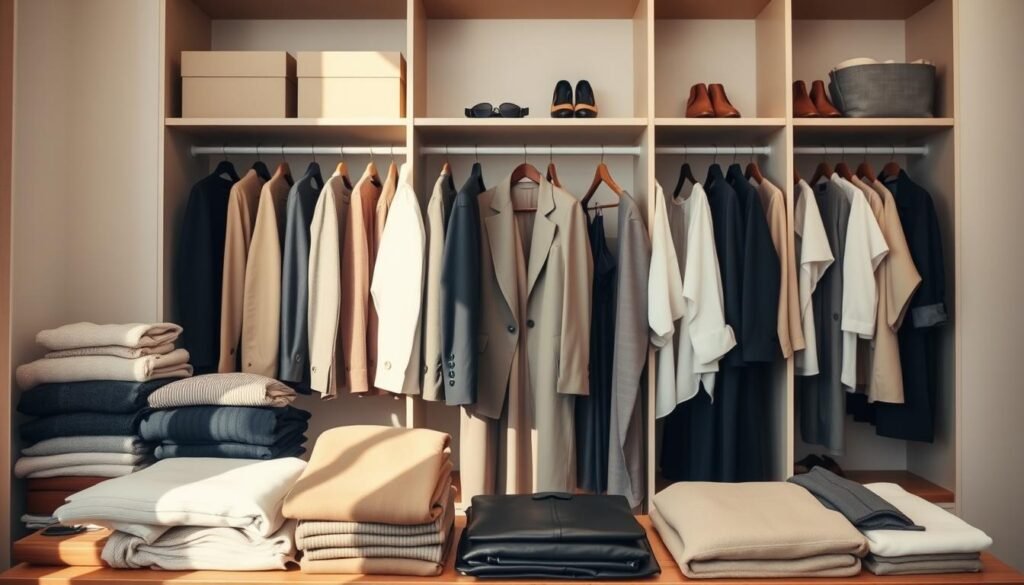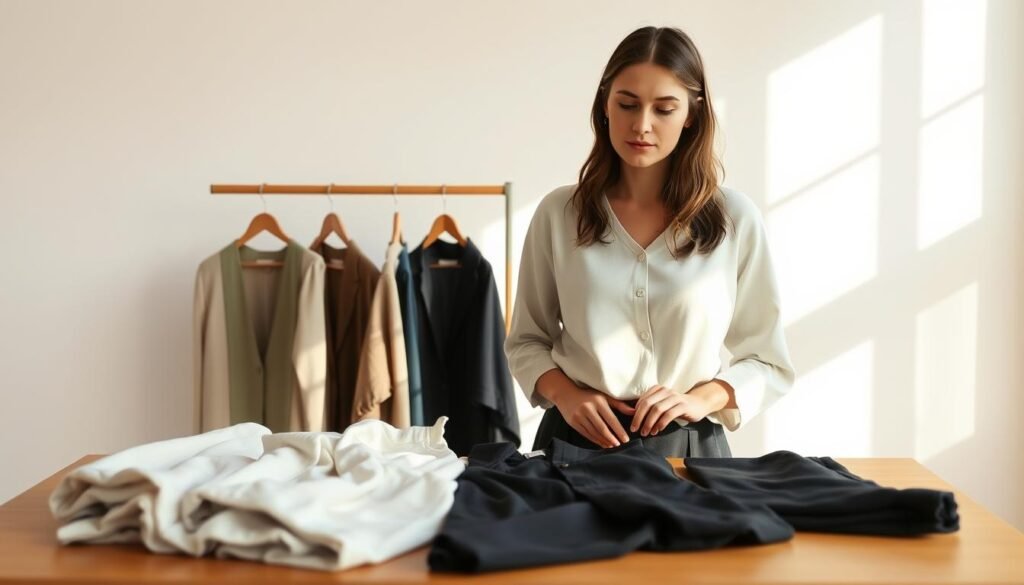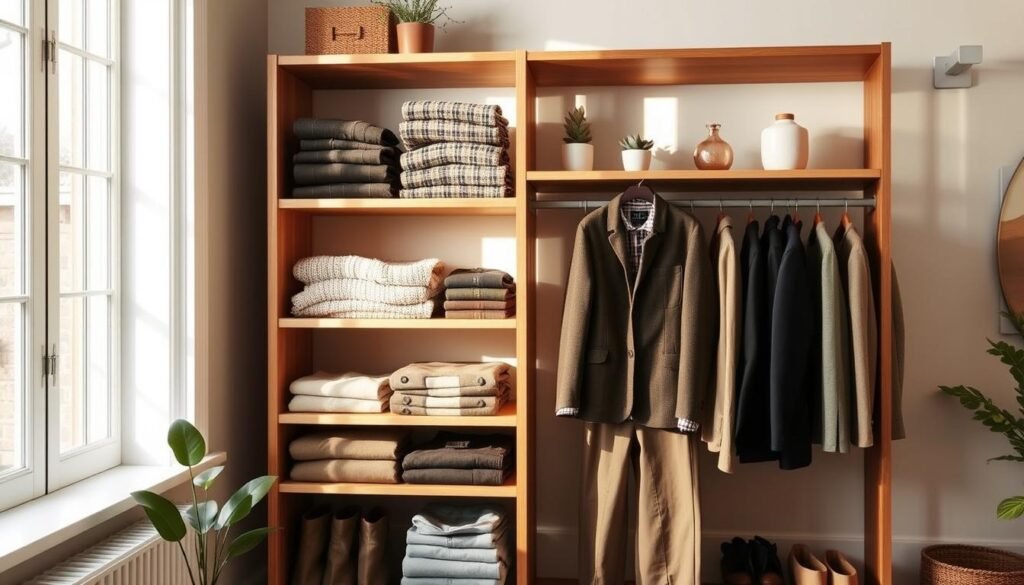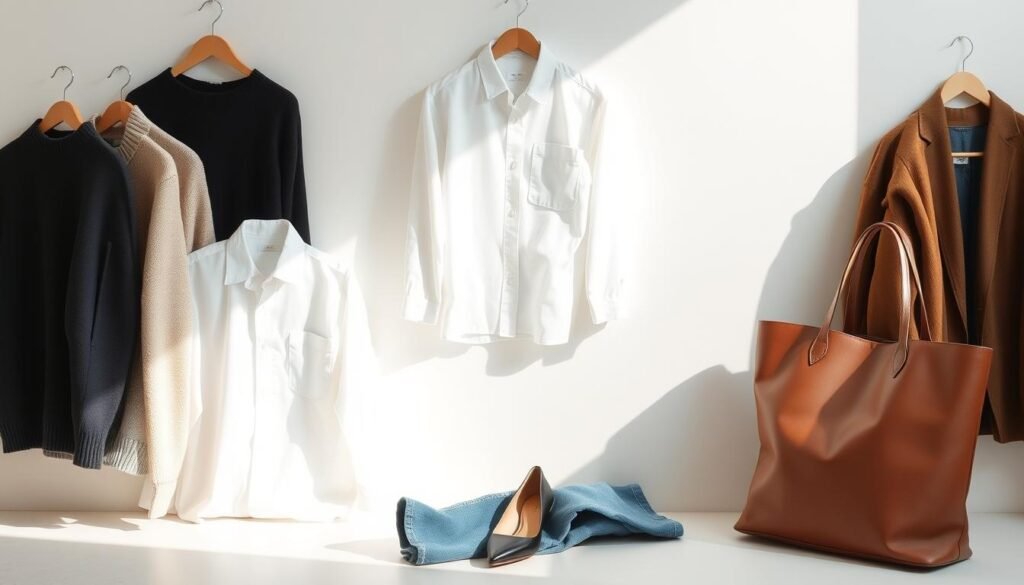“The secret of getting ahead is getting started,” said Mark Twain. This wisdom perfectly captures the journey toward building a thoughtful, intentional collection of clothing that serves you well.
Creating a curated selection of versatile pieces changes how you dress every day. You’ll no longer be overwhelmed by a crowded closet. Instead, you’ll have items that go well together.
The idea started in the 1970s when Susie Faux opened “The Collection” in London. She focused on quality basics that could be mixed and matched. Donna Karan made this idea popular in 1985 with her “Seven Easy Pieces” collection.
Today, sustainable fashion is more popular than ever. People want to lessen their environmental impact and simplify their lives. A well-thought-out collection saves money and adds style versatility.
Key Takeaways
- Capsule collections originated in 1970s London and gained mainstream popularity through Donna Karan’s designs
- Focus on quality over quantity when selecting wardrobe essentials for long-term value
- Choose versatile pieces that can be mixed and matched for multiple outfit combinations
- Sustainable fashion practices reduce environmental impact while saving money
- Invest in timeless fashion basics instead of trendy items that quickly go out of style
- Start small with 20-30 carefully selected pieces that reflect your lifestyle and preferences
Understanding What a Capsule Wardrobe Really Means
What is a capsule wardrobe? It’s more than just a few clothes. It’s about picking items that can be mixed and matched easily. This way, you can make many outfits from just a few pieces.
Did you know you only wear 20% of your clothes 80% of the time? That means a lot of clothes just sit there. A smart wardrobe focuses on the 20% you really use.
Defining the Capsule Wardrobe Philosophy
The idea behind it is about making intentional choices. Each item should do more than one thing and go well with others. This makes your wardrobe work together smoothly.
Quality is more important than how many clothes you have. Buying a few good pieces is better than lots of cheap ones. It’s about building a solid wardrobe, not just buying more.
Key Benefits of Minimalist Fashion
Minimalist fashion has big benefits for daily life. Decision fatigue goes down when you have fewer choices. This saves time and mental energy for other things.
It also saves money. You spend less but get better quality clothes that last longer. Plus, it’s better for the planet by reducing waste.
Debunking Common Capsule Wardrobe Myths
Some think capsule wardrobes are boring or limiting. But, strategic curation actually increases outfit variety. The right pieces can create more looks than random ones.
Another myth is it costs more at first. But, while quality pieces cost more upfront, they save money in the long run. This makes the capsule wardrobe a smart choice financially.
Step 1: Evaluate Your Current Wardrobe and Lifestyle

Starting a capsule wardrobe means looking at what you own and how you live. This step saves time and money. It makes sure your wardrobe essentials fit your life perfectly. Without this, you might end up with clothes that don’t fit your lifestyle.
Conducting a Complete Closet Inventory
Begin by emptying your closet and sorting items. Put similar things together, like jeans and dresses. Seeing what you have helps a lot.
Then, sort items into three piles. The first pile is for things you love and wear often. The second is for items you hardly use. The third is for clothes that are damaged or out of style.
Be ruthless when sorting. If you haven’t worn something in a year, it might not belong. Put away seasonal clothes that aren’t needed now.
Analyzing Your Daily Activities and Dress Requirements
Your lifestyle shows what wardrobe essentials you need. Write down your weekly activities. This shows what you actually wear.
Think about your work environment. Do you need formal clothes or casual ones? How often do you go to events that require dressier outfits?
Identifying Your Personal Style Preferences
Look at your favorite clothes to find patterns. Notice your favorite colors and styles. These will help choose your capsule wardrobe.
| Style Element | Questions to Ask | What This Reveals |
|---|---|---|
| Colors | Which colors make you feel confident? | Your ideal color palette |
| Fit | Do you prefer loose or fitted clothing? | Silhouette preferences |
| Fabrics | What textures feel best on your skin? | Comfort and quality needs |
| Patterns | Do you choose solids or prints more often? | Visual style direction |
Notice which clothes make you feel great. These insights will help you create a capsule wardrobe that’s true to you and practical.
Step 2: Define Your Capsule Wardrobe Parameters
Setting clear boundaries for your capsule wardrobe ensures every piece works together seamlessly. These parameters act as your personal shopping guide. They help you make smart clothing decisions. Without them, you might end up with pieces that don’t coordinate well or serve your lifestyle needs.
Think of these parameters as the foundation of your minimalist wardrobe strategy. They prevent impulse purchases and keep you focused on building a cohesive collection.
Selecting Your Core Color Scheme
Neutral colors form the backbone of any successful capsule wardrobe. Focus on timeless shades like black, navy, gray, brown, camel, taupe, cream, and white. These colors mix and match effortlessly, creating countless outfit combinations.
Choose neutrals that complement your skin tone and personal preferences. If you love adding personality to your outfits, incorporate one or two accent colors that work beautifully with your neutral base. This approach maintains versatility while expressing your individual style.
Determining Your Ideal Piece Count
A functional minimalist wardrobe typically contains 28 to 42 pieces, but don’t get stuck on exact numbers. Your ideal count depends on your lifestyle, climate, and personal needs. Someone working from home requires fewer professional pieces than an office worker.
Start with the current season and build gradually. Quality matters more than quantity, so focus on pieces that truly serve multiple purposes in your daily routine.
Planning for Seasonal Variations
Smart seasonal planning keeps your capsule wardrobe relevant year-round. Identify core pieces that work across seasons, then add weather-specific items as needed. Transitional pieces like lightweight cardigans and versatile jackets bridge the gap between seasons effectively.
Plan storage solutions for off-season items to maintain an organized, functional closet space.
Step 3: Choose Your Foundation Wardrobe Essentials

Building a capsule collection starts with key wardrobe essentials. These pieces should fit together like a puzzle, creating many outfit options. It’s better to have quality over quantity in your core collection.
Choose items that work for both casual and professional settings. Each piece should match with several others in your collection.
Essential Tops for Maximum Versatility
Start with high-quality basic tops that keep their shape. Premium tees and tanks are worth the investment because cheap ones lose shape quickly.
Brands like Khaite, Skims, and ETERNE make tops that last. For affordable options, look at Quince for quality basics at good prices.
Stick to neutral colors that fit your color scheme. Aim for 5-7 basic tops and 3-4 blouses that can dress up or down.
Must-Have Bottoms That Mix and Match
Your bottom collection should cover different occasions and body types. Start with 2-3 pairs of well-fitted jeans in classic washes.
Add 2-3 pairs of pants or leggings based on your needs. Include 2-3 pairs of shorts for warm weather and 1-2 versatile skirts for any setting.
Choose durable fabrics and colors that match your wardrobe. Quality denim and structured pants are better than trendy items.
Key Layering Pieces and Outerwear
Layering pieces add to your outfit options and adjust to weather changes. Invest in 3-4 quality sweaters in various weights and styles.
Have 2-3 jackets or coats for different uses. A structured blazer makes casual outfits professional, while a versatile cardigan adds warmth and style.
| Category | Recommended Quantity | Key Features | Versatility Factor |
|---|---|---|---|
| Basic Tees/Tanks | 5-7 pieces | Quality fabric, classic fit | Pairs with all bottoms |
| Jeans | 2-3 pairs | Classic washes, proper fit | Casual to smart-casual |
| Sweaters | 3-4 pieces | Different weights, neutral colors | Layering and standalone wear |
| Blazers/Jackets | 2-3 pieces | Structured, professional quality | Transforms any outfit |
Step 4: Build Your Professional Capsule Collection
Creating a capsule wardrobe for work means picking pieces that are both versatile and professional. Your clothes should look good whether you’re in a meeting or a casual team gathering. It’s all about mixing style with practicality.
Professional clothes are key to your capsule wardrobe. They should be able to go from a big meeting to a networking event without a hitch.
Selecting Work-Appropriate Blazers and Jackets
A black blazer is essential for any work capsule wardrobe. It’s like the little black dress of jackets, fitting well with both formal and casual clothes.
Make sure your blazers fit well, from shoulders to waist. Opt for classic styles that won’t go out of fashion soon. A navy blazer is also a great choice, fitting for many seasons and events.
Think about the fabric too. Lightweight wool blends are good all year, while cotton blazers are better for warmer places and more relaxed settings.
Choosing Professional Dresses and Separates
Professional dresses should be able to be worn in different ways. Pick styles that can be worn alone or under blazers for different looks.
Sheath dresses in solid colors are very versatile. They look great on their own and with various accessories and jackets.
Quality separates let you create many outfits. Choose pieces that go well together. Look for blazer and trouser sets that can be worn together or apart.
Adding Business Casual Options
Business casual items are great for mixing formal and casual clothes. They make your capsule wardrobe more useful in different work settings.
Knit blazers are comfy but professional. They’re perfect for creative jobs or casual Fridays. Dark wash trousers are a smart choice instead of traditional dress pants.
Pick items that can easily switch from work to casual settings. This way, every piece in your collection gets used more.
Step 5: Select Quality Shoes and Accessories

Quality footwear and accessories are key to making your fashion basics stand out. They can turn simple outfits into stylish looks. The right pieces also let you create more outfits without cluttering your closet.
Choosing the right accessories opens up a world of possibilities. A single dress can become three different looks with different shoes and jewelry. This way, you get more from your wardrobe while keeping it simple.
Essential Footwear for Every Occasion
Every wardrobe needs four essential shoe pairs for all occasions. White sneakers are versatile and go with everything from dresses to jeans. They add a modern touch to any outfit.
Nude or black strappy heels are perfect for evening and professional looks. Ballet flats bring timeless elegance for everyday wear. Loafers add a touch of menswear style that’s both feminine and trendy.
Versatile Bags and Handbags
A good leather tote is great for workdays and weekend chores. Opt for neutral colors like black, brown, or navy for versatility. It’s a smart investment that lasts for years.
For hands-free convenience, a crossbody bag is ideal. It’s perfect for travel, shopping, and casual outings. Look for one with adjustable straps for comfort.
Jewelry and Accessories That Transform Looks
Accessories can make basic pieces into standout outfits. A chunky gold necklace can elevate a simple white tee. Black belts help define waistlines and add structure to loose clothes.
Choose accessories that mix and match with your entire wardrobe. Quality pieces last longer and look better than trendy ones.
| Accessory Type | Essential Pieces | Styling Impact | Investment Level |
|---|---|---|---|
| Footwear | White sneakers, nude heels, ballet flats, loafers | Changes outfit formality | Medium to High |
| Handbags | Leather tote, crossbody bag | Adds functionality and polish | High |
| Jewelry | Gold necklace, stud earrings, watch | Creates focal points | Medium |
| Belts | Black leather, brown leather | Defines silhouette | Low to Medium |
Step 6: Master the Mix and Match Strategy
Learning how to style your clothes is key to making the most of your capsule wardrobe. It’s about knowing how your wardrobe essentials can be mixed and matched to create new looks. This way, a small collection can become a treasure trove of outfits.
Begin with a piece you love and try to style it in five different ways. This will show you new combinations you might not have thought of. Take pictures of outfits you enjoy so you can refer to them when you need inspiration.
Creating Multiple Outfits from Minimal Pieces
The one piece, many ways method is a smart way to use your wardrobe essentials. Start with something versatile like a white button-down shirt. You can wear it with dark jeans for a casual look, tucked into a skirt for work, or over a sundress for a summer vibe.
To balance your outfits, follow some simple rules. Wide-leg pants look great with fitted tops, and flowing blouses work well with slim-fit pants. Remember, if your top is loose, your bottom should be fitted, and vice versa.
Make a mix and match plan that works every time. Pick three tops, three bottoms, and two layering pieces. This will give you at least eighteen different outfits from just eight items.
Layering Techniques for Different Weather
Layering is a great way to use your wardrobe essentials all year round. In summer, start with light layers and add cardigans or blazers for cooler spaces. This simple trick keeps you comfortable and stylish.
In winter, layering is even more important. Try wearing thin sweaters under blazers or layering a sleeveless dress over a long-sleeve shirt. These tricks add style and keep you warm.
Transitioning Outfits from Casual to Formal
Quickly change a casual outfit into a formal one with a few simple swaps. Swap sneakers for heels, add bold jewelry, or throw on a blazer. These changes can make a big difference in how you look.
Get good at mix and match by practicing these transitions. A simple tee and jeans can become office-ready with the right accessories and shoes.
Step 7: Shop Smart for Long-Term Success

Creating a successful capsule wardrobe means changing how you shop. You should think before buying, not just follow trends. This new way of thinking changes how you see fashion and money.
By not buying things you don’t need, you can spend on quality items. Well-constructed garments from good materials look better and last longer.
Investing in Quality Over Quantity
Quality items might cost more but save money in the long run. Choose natural fibers like cotton, wool, and silk. They get better with age. Look at the details like strong seams and good zippers.
A good blazer might be three times as expensive as a cheap one. But it keeps its shape and looks great for years. It’s a smart choice for your fashion basics.
Strategic Shopping Timeline and Budget
Grow your capsule wardrobe slowly, over 6-12 months. Start with the essentials and add more later. Set a budget that lets you buy quality without breaking the bank.
Buy during sales at the end of seasons for deals on good items. Plan your purchases based on what you really need, not just what you want.
Avoiding Common Shopping Mistakes
Don’t buy things that only go with one other item. Stay away from colors that clash with your wardrobe. And skip trendy items that won’t fit with your capsule wardrobe.
Always try on clothes and think about how they’ll mix with what you already have before buying.
Step 8: Organize Your Capsule Wardrobe Effectively
Organizing your capsule wardrobe makes it efficient for daily use. It makes getting dressed quicker and more fun. You’ll also see all your options clearly, making it easy to mix and match outfits.
Implementing Efficient Closet Organization
Set aside a part of your closet for your capsule wardrobe. If you can, move other clothes to another closet or storage area. This keeps you from feeling overwhelmed by too many choices.
Sort your clothes by type and color for easy mix and match outfits. Group similar items together, like all blazers in one spot and dresses in another. Use matching hangers for a clean, uniform look.
If you have a small closet, use double-hanging rods or shelf dividers. These help use vertical space and keep everything visible. A well-organized system like this closet mission approach helps you keep your capsule wardrobe in order.
Proper Garment Care and Storage Methods
Quality clothes need quality care. Different fabrics need different care – wool needs air, while cotton can be folded. Store delicate items in breathable bags to prevent damage.
Choose good hangers that keep clothes in shape. Cedar blocks or lavender sachets keep clothes fresh and protect against moths. Proper storage makes your clothes last longer.
Creating a Maintenance Schedule
Make a weekly routine for keeping your wardrobe in check. Look for stains, loose buttons, or repairs. Monthly reviews help you see what’s working and what needs a change in your mix and match system.
| Frequency | Task | Purpose | Time Required |
|---|---|---|---|
| Weekly | Quick condition check | Spot issues early | 10 minutes |
| Monthly | Deep organization review | Maintain system efficiency | 30 minutes |
| Seasonally | Complete wardrobe assessment | Plan updates and replacements | 2 hours |
Step 9: Adapt Your Capsule for Seasonal Changes

Changing your minimalist wardrobe with the seasons doesn’t mean you have to start over. Smart planning keeps your capsule useful while keeping it simple. The trick is to make smart changes, not a full wardrobe change.
Start with what you can wear now. If something doesn’t fit the current season, save it for later. This way, you avoid clutter and keep your wardrobe essentials easy to find and use.
Incorporating Transitional Pieces
Transitional pieces are key for adapting to different seasons. Look for items that can be worn in more than one season. For example, a lightweight cardigan can go from summer to fall.
Here are some must-have items:
- Blazers that can be worn over tank tops or sweaters
- Ankle boots good for three seasons
- Midi dresses that can be layered with tights and cardigans
- Denim jackets for spring and fall
Seasonal Storage and Rotation Systems
Set up good storage for easy season changes. Use vacuum-sealed bags for big winter items. Keep off-season clothes in labeled bins or bags.
Swap items gradually instead of all at once. Switch from sandals to closed shoes as it gets colder. This keeps your capsule useful during changes.
Adding and Removing Weather-Specific Items
Know which items need to change with the seasons and which are always useful. Heavy coats and swimwear need to be stored, but many items can be styled differently for different seasons.
Add items that are specific to certain weather. Have a warm coat for winter and light layers for summer. Remove items that only fit one season. This keeps your capsule focused and useful.
Maintaining Your Fashion Basics for Long-Term Success
Your capsule wardrobe journey doesn’t end once you’ve assembled your essential pieces. Long-term success requires ongoing attention and smart maintenance strategies. Think of your wardrobe as a living system that grows and adapts with you over time.
Give yourself a few weeks to get comfortable with your new, smaller wardrobe and experience the benefits. Your style will naturally evolve as you discover which pieces work best for your lifestyle.
Regular Wardrobe Assessment and Updates
Schedule quarterly reviews to evaluate your capsule wardrobe performance. After 30 days, you’ll likely feel ready to let go of items you couldn’t part with initially. This natural progression helps refine your collection further.
During each assessment, ask yourself key questions about each piece. Does it fit your lifestyle? Do you reach for it regularly? Items that consistently go unworn should be reconsidered.
Replacing Worn Items Strategically
When fashion basics show wear, replace them thoughtfully. Look for similar styles in better quality fabrics or improved fits. This approach maintains your capsule’s integrity while upgrading your collection.
Quality replacements often cost more upfront but provide better long-term value. Consider this an investment in your wardrobe’s sustainability and your personal style consistency.
Evolving Your Capsule with Lifestyle Changes
Major life transitions require capsule wardrobe adjustments. Career changes, relocations, or lifestyle shifts may demand different clothing priorities. Your fashion basics should always serve your current needs.
Track these changes through a simple maintenance schedule. This helps you stay proactive, not reactive, when updates become necessary.
| Timeline | Assessment Focus | Action Items | Expected Outcome |
|---|---|---|---|
| 30 Days | Initial Comfort Level | Remove unused pieces | Refined capsule wardrobe |
| 3 Months | Seasonal Performance | Evaluate versatility | Improved functionality |
| 6 Months | Wear Patterns | Replace worn items | Maintained quality |
| 1 Year | Lifestyle Alignment | Major updates if needed | Evolved style system |
Conclusion
Building a capsule wardrobe makes getting dressed easy and fun. You now have the tools to turn messy closets into organized, intentional dressing. This saves time, money, and mental energy every morning.
Fashion basics are powerful because they work well together. By mastering mix and match, you can create many outfits from a few pieces. Each item does more than one thing, giving you lots of options with less spending.
Your capsule wardrobe journey also helps the planet and your wallet. Choosing quality over quantity means less waste and more money saved. It takes time, but every step makes getting dressed better.
Start your journey today by checking your current wardrobe. Begin with one type of clothing and add more slowly. Choose pieces that fit your lifestyle and style.
Remember, building the perfect capsule wardrobe is a journey that gets better with time. Even small steps towards better dressing can change your day and confidence. Your future self will thank you for the simplicity and quality of your wardrobe.

